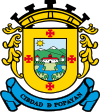Popayán
| Popayán | |||
|---|---|---|---|
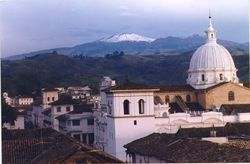 |
|||
|
|||
| Nickname(s): "The White City" | |||
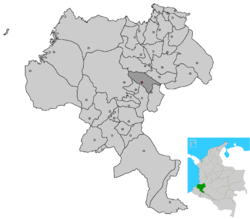 |
|||
 Popayán
|
|||
| Coordinates: | |||
| Country | |||
| Departamento | Cauca | ||
| Foundation | 13 January 1537 | ||
| Government | |||
| - Mayor | Ramiro Navia | ||
| Area | |||
| - Total | 483.11 km2 (186.5 sq mi) | ||
| Elevation | 1,737 m (5,699 ft) | ||
| Population (2005 census)[1] | |||
| - Total | 258,653 | ||
| - Density | 535.3/km2 (1,386.4/sq mi) | ||
| Time zone | EST (UTC-5) | ||
| - Summer (DST) | not observed (UTC-5) | ||
| Website | http://www.popayan.gov.co | ||
Popayán is the capital of the Colombian department of Cauca. It is located in southwestern Colombia between the western mountain range and central mountain range. It has a population of 258,653 people (DANE 2005), a territorial extension of 512 Km2, is located 1760 meters above sea level, and has an average temperature of 18/20ºC.
This town is well-known because of its beautiful colonial architecture and its contributions to Colombian cultural and political life. It is also known as the "white city" due to the color of the most of colonial houses and places at city downtown, where several churches are located, such as San Francisco, San José, Belén, Santo Domingo, San Agustín, and the Catedral Basílica Nuestra Señora de la Asunción, known locally as "La Catedral".
The city's cathedral was home to the Crown of the Andes, a 16th century Marian devotional object featuring emeralds taken from the captured Inca Emperor Atahualpa before its sale to finance local healthcare institutions.
Much of the city's original splendor was destroyed on 31 March 1983, when an earthquake toppled many buildings. Though many of them were rebuilt and repaired, the heart of the city still bears ruins and empty lots since the disaster.
Popayán has been home to seventeen colombian presidents, as well as noted poets, painters, and composers. The University of Cauca (est. 1827), one of Colombia's oldest and most distinguished institutions of higher education, is located here; that is why Popayan is also known as the "Universitary City."
Nearby is Puracé National Park, a geothermal wonderland of hot springs, waterfalls, and an inactive volcano from which the park derives its name. The nearest large city is Cali, in the neighbouring department of Valle del Cauca, to the north of Cauca.
In 2005, Popayán was declared by the UNESCO as the first city of gastronomy because of its variety and meaning to the intangible patrimony of Colombian culture. The culinary history of the Cauca department was chosen baceuse of their maintaining of traditional methods of food preparation which has been passed over through different generations orally. On 2009 September 28, UNESCO also declared the processions of the Easter Week processions as a Masterpiece of the Oral and Intangible Patrimony of Humanity.
Contents |
History
Name Origin
The word Popayán comes from a Native American dialect. There are some theories about the origin of this word, one of them says that it means: Po: Two; Pa: Straw; Yan: Village. It`d be Two villages with straw roofs. However there is no straw roofs in town any more although there is plenty of them in the city neighborhood.
Other theory says that the word Popayán comes from the name of the Payán indigenous leader, who used to live around Eme hill, nowadays known as Las Tres Cruces Hill.
Another theory says that according to the historian Arcecio Aragón, the origin of the word Popayán is "Pampayán" and it comes from the quechua dialect, as follows: Pampa: Valley, ; and Yan: river; or in other words, the pass of the river, the Cauca river.
Colonial Era
There are no records regarding the pre-Hispanic history of the indigenous town of Popayán, but in 13 January 1537 Spanish conqueror Sebastián de Belalcázar came to the conquered town and declared the foundation of Popayán. During the sixteenth and seventeenth centuries, Popayán was administered by an appointed governor under the jurisdiction of the Royal Audience of Quito.
Popayán was a very important town during the colony because of its location between Lima, Quito and Cartagena. Even after the discovery of the Pacific Ocean, Popayán was a transfer point of gold and riches going to Cartagena on its way to Spain. Popayán also served as a colonial mine, producing various denominations of the Escudo gold coins and silver Reales from 1760 through 1819; and continued producing coinage for the new Republic of Colombia after 1826. [1]
Natives populated the town before the América Conquest. Next to the city there is still a huge mound built by the Indians, similar to a pyramid and now covered by grass; legend says the inner structure holds richness and gold. Later, conquerors settled next to the Indians taking advantage of their good heartiness and cheap labor, and Catholicism was offered and taken by the Indians in exchange for their gold and work.
As a result of his importance in the colony times, Popayán is one of the most traditional Colombian towns and very rich in Colonial architecture; and although in 1983 an earthquake destroyed part of the city, there are several colonial bridges, museums and churches in the town.
The city is home of an ancient Pre-Hispanic pyramid known as El Morro de Tulcán. It was abandoned when first Spanish arrived to the city in 1535. Analysis of dental samples have revealed that individuals buried probably belonged to the most important social class from their respective Indian society.
Popayán has been destroyed by several earthquakes. The most recent and destructive lasted eighteen seconds and occurred on 31 March 1983. The reconstruction of the colonial city took more than 10 years and today it`s still possible to see some lots that have not been reconstructed. The first earthquake seismic design code was established in Colombia as a consequence of this earthquake.
The Antique City Popayán Historic Downtown is considered one of the most beautiful and best preserved in Colombia and Latin America. Popayán has preserved its colonial architechture for more than four centuries, reason why national colombian and foreign visitors are seduced by its historic downtown. The cobblestone streets were almost all paved in 1937, however, there are a few projects which are currently being implemented to recover the old city original look.
Places of Interest
El Morro de Tulcán
It`s the main archaeological site of Popayán. It consists of a truncated pyramid built in prehistoric times, approximately between 500 and 1600 A.C., a period known as late chiefdom societies. In 1937 to commemorate the 400th anniversary of the foundation of the city, a monument was opened in 1937 at the top of the hill in honor of the founder of the city, Sebastián de Belalcázar, with an equestrian statue made by the Spanish artist Victorio Macho.
Francisco José de Caldas Auditorium
Better known as the Paraninfo, it is an imposing building of the mid eighteenth century and it was part of the monastery of the Dominicos order until 1826. First, it was built in mud and straw roof, then it was reinforced over the years with rammed earth and tile, until it became a colonial architecture expression again. Simón Bolivar declared it in 1827 as a property with historic heritage value , when it was already a two steps hose in front of the Santo Domingo plaza. The last great governor of Cauca, don Miguel de Arroyo Hurtado, made more renovations and reforms that gave it the most current look. When the building was handed over to the University of Cauca in the early twentieth century, several chages and and additional extensions were made, which recovered all the original spaces.
Caldas Park
This park, common passageway of students, executives, and all citizens, and cultural reunion place, it was born at the same time of Popayán in 1537, when the track in grid generated around religious, gobermental, and founders buildings. Initially it was used as a marketplace. In 1538 it was placed a trap in the center of the park, where Jorge Robledo y Álvaro Oyón were beheaded. This trap lasted until 1766 when it was replaced by a faucet of water, which lasted until 1805 when it was put a stone pile in its place, but it was removed too in 1910 after the inauguration of the monument to Sabio Caldas, piece of the french sculptor Raoul Verlet, which has remained since that times in the same place. It exist a replica located in the Plazoleta de las Nieves in Bogota. At the same time there were planted leafy trees which currently round up the monument an embellish this place. In May 2007 it was made a proposal of architect Lorenzo Castro to remodel Caldas Park by expanding the pedestrian zone around the park, and in April 2009 it was opened the first phase of the work in the park, in preparation for the celebration of Easter, a touristic time for Popayán.
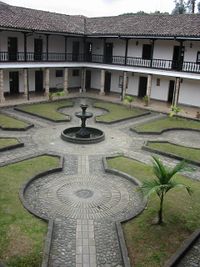
University of Cauca
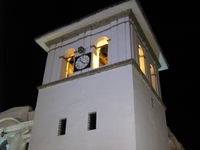
It´s the main university of Popayán, which gathers students from around the country. It was founded in 1827 by decree of General Francisco de Paula Santander. Its currency is Posteris Moriturus Edat Lumen. Since the beginning of the twentieth century, the main headquarters has been placed in the old convent of the Dominican Order, cloister which is one of the best examples of religious architecture in the city.
Clock Tower
It is the main symbol of the city, and it was called as “the nose of Popayan” by Master Guillermo Valencia. It´s a construction placed next to the Cathedral church, built among 1673 and 1682 years, with 96 thousand bricks.
The clock, made in England, was placed in 1737. Its mechanism operated by the action of two lead weights which were changed by Antonio Nariño in the Colombia independence dispute in 1814, when metal required to manufacture ammunition.
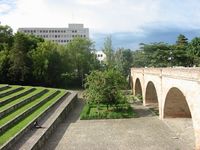
After the earthquake of 1983, the clock was restored and put back in operation by the same English company that manufactured it, but a lot of time ago it doesn't work anymore.
Humilladero Bridge
It connects the center zone with the north zone of the city. It was built in 1873 on arches of brick and masonry, according to Italian religious Fray Serafin Barbetti designs and a German engineer whose mummified remains are preserved in the Archdiocesan Museum of Religious Art in the city. Between downtown and El Callejón neighborhood, now Bolivar neighborhood, there is a fault that before the bridge construction it turned extremely difficult to go to downtown and due to this circumstance people rose almost on their knees. And that´s why it was called Humilladero. For a long time this bridge was one of the main entrances to the city, the liberating armies entered trough it during the gestation of Colombia independence. Its cool design and strong construction have allowed it to get out intact from many earthquakes.
Churches
San Francisco
According to the architect, critic and historian Germain Téllez, the facade of this temple is the best example of baroque style throughout Colombia. In its tower is placed a famous bell donated by Don Pedro Agustín de Valencia. This temple is remarkable because of its altars decorations and its naves and apse proportions. In the San Francisco`s square, it stands the monument to the local hero Camilo Torres, whose replica is located in the square of the Colegio Mayor de San Bartolomé in Bogotá.
Santo Domingo
Late Neogranadino Baroque work, designed by the Spanish architect Antonio Garcia. It has excellent examples of architectures, metal works, and furniture from Quito and Spain schools. His pulpit was designed in the first half of the nineteenth century by an illustrious son of the city, the Wise Francisco José de Caldas. Next this church is located the faculty of Laws and Political and Social Sciences of the University of Cauca. Whose style is colonial too.
San Agustín, Church and convent
Fray Jeronimo Escobar founded the convent of the Augustinians in the late seventeenth century, whose temple was destroyed in the earthquake in 1736. Then, it was reconstructed thanks to contributions from notable people of the city, but it was necessary to restore it again after the earthquake of 1983. In particular it stands out its altar carved in wood and covered in gold, its expository baroque made in silver and a beautiful image of the Lady of Sorrows.
La Ermita
It´s the oldest church in the city and sometimes it served as “Pro Tempore” Cathedral. It dates from 1546 and contains a fine altar discovered after the earthquake of 1983. The principal attraction of this church is the street where its ubicated, because of its road made by stones, like old roads in Popayán.
Catedral Basílica Nuestra Señora de la Asunción
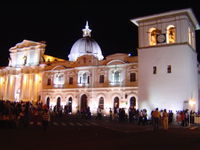
Originally it was a straw hut, but in 1609 it was opened a second cathedral of mud and masonry. The current construction was consecrated in 1906 by Archbishop Manuel Antonio Arboleda, who brings it a magnificent european pipe organ. Its style is the neoclassical, and much of the building was restored because of the earthquake of 1983, including the great dome of 40 meters high, whose restoration was made according to guidelines of the original structure designed by the local artist Adolfo Dueñas.
San José
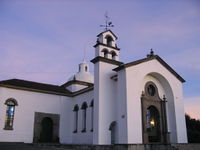
It was built in 1702 according to the architectural guidelines of the Jesuits in the American Baroque. It has put up with some changes, for example, the most recent occurred in 1983, when much of the facade which had been covered with paint and lime for at least two centuries, was left on view.
Belén Chapel
It´s located on the hill of Belén, and from the chapel you can see a panoramic view of the city. To arrive to this church, it´s necessary to pass through the “quingos", a road of stone steps that allow a nice climb to one of the viewpoints of the city.
Since 1717 this chapel is in charge of the image of Santo Ecce Homo, patron saint of the city. Next to the church there is a cross of quarry stone of 1789, which are attributed to many legends. The original church was completely replaced by a new structure after the earthquake of 1983.
Museums
House-Museum Mosquera
This house displays a very interesting collection of colonial art and precious memories of the Mosquera family. It works in the house that belonged to the Mosquera Arboleda family, a recognized family in the history of Colombia, whose members occupied the highest positions of political power, ecclesiastical, military and diplomatic, simultaneously during much of the nineteenth century. The most important were: Joaquín Mosquera, Tomás Cipriano de Mosquera, Manuel José Mosquera and Manuel Maria Mosquera. The father of them all, Jose Maria Mosquera y Figueroa, was considered by the Liberator Simón Bolívar as the only person he would choose as a second parent.
Archdiocesan Museum of Religious Art
The old residence of the Arboleda family, was built in the eighteenth century based on plans of the priest Andres Perez Marcelino Arroyo, and it was acquired by the city in 1974 and renovated for its current use in 1979. Their collections are extraordinary examples of religious art, silverware, pictures of the so-called Quito School and paintings of the colonial period. Monstrances of the collection have such value that they are only exposed to the public for a few days during Easter.
National Museum Guillermo Valencia
It`s located in a mansion on the Próceres Street, and it is dedicated to the poet Guillermo Valencia, one of the most prominent members of Modernism in spanish letters. Its numerous rooms are decorated with valuable works of art and artistic pieces, as well as a collection of hundred of selected books, diplomas, medals and awards that Master Valencia received for his distinguished political life and for its fine literary and poetic compositions. In the park located across the street it stands the statue of the poet, made by the spanish sculptor Victorio Macho. It has too a family cemetery where the remains of several generations of Valencia are resting.
Natural History Museum
It offers an exhibition of animals, like insects, butterflies and birds native to the region, and a collection of pre-Columbian pottery.
Arts & Culture
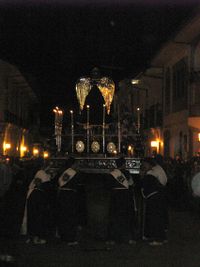
Easter
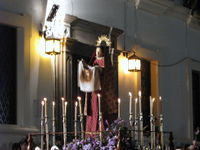
Popayán is widely known by the solemnity of Easter processions during which commemorates the passion and death of Jesus Christ. Since the sixteenth century (in documents in the historical archives of Popayán, it mentions about processions in the 1558 year) processions have performed continuously in the night since Tuesday until Holy Saturday, when ancient religious images parade through Popayán historical downtown streets and they go arranged on wooden platforms with 4 horizontal "bars" to the front (a kind of turned wooden beams) and 4 bars back, as supports to the shoulders of the “Cargueros” or those responsible for transport the platform.
"Ester processions are representations of different episodes narrated in the Gospels, on the Passion, Crucifixion and Death of Jesus Christ, where each one of these representations is called "Paso". Since the conquest beginning, the pasos are taken through the streets on the shoulders of traditional carguero, in a route traced on a cross, including the main churches and temples of the city.
During this week, Popayán is also home to the Festival de Música Religiosa (Religious Music Festival), which began in the 1960s by initiative of Edmundo Mosquera Troya. This festival presents choirs, soloists and artists from around the world, specialits in sacred music. Also it`s the tradition for this period of the year that it be realized samples and sellings of handicrafts and commercial products. One of the most important handicrafts samples is Manos de Oro, where it exposes the several works of artists of Colombia.
Fiestas de Pubenza
Popayán celebrate these festivity at the beginning of the year, from January 5th to 13th by playing in its streets to celebrate the racial diversity spirit of the country, just like the Carnival of Blacks and Whites in Pasto, which originally initiated in Popayán during slavery ephoc as a method of escape of the racial discrimination that prevailed at the time.
Music
It is said that among the original performers there were good music interpreters, emphasizing on the execution of the “Chirimía”, that is made up of flutes (transverse cane) guacharacas, drums, castrueras and triángulos, making its appearance in the traditional celebrations of Popayán, especially on Christmas time and at the end of the year.
On the plateau of Popayán, groups of farmers plays stringed instruments, composed of three guitars and maracas which have incorporated into their repertoire paseos, merengues, pasillos and boleros in vocal and instrumental form. Popayán is also the birthplace of modern rhythms such as Salsa and Rock, being recognized exponents of these genres and national and international artists, as Fueradequicio rockers, among others, also including personalities as Juanes manager Fernan Martinez and music producer David Chicaiza.
Gastronomy
Popayán is the only one place in Latin America which have been declared City of Gastronomy of UNESCO, due to the offering of its local cooking. The typical dishes of the city are a legacy of spanish and indigenous cultural interaction, integrating special components of the region with fruits brought from Spain.
The National Gastronomy Congress of Popayán is celebrated since 2003, during the September month, and it`s also recognized by the UNESCO in 2005 as cultural heritage of the United Nations creative network. The Congress is organized by the Gastronomic Corporation of Popayán which has reached its seven editions having the participation of some countries as special guests: Peru, Brazil, Spain, Chile, Mexico, Italy and France. Today, this congress is recognized as the second largest popular event in the Cauca Department. Because of being an academic format, it`s distinguished among other culinary competitions and it`s listed as the only one nationally.
Among the typical food we can find:
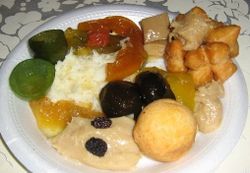
Carantanta: is a type of fried snacks that results from the sticked corn in the pot where it have been made the corn dough.
Soups: Shaked Broth, Sancocho, tortilla soup, Sango, carantanta soup, wrappes soup, vegetable and pastries soup.
Dishes: Pipián tamales, empanadas de pipián, Calf.
Vegetables: Ullucos, corn wrappes.
Sauces and seasonings: pique chili, peanut chili, pineapple chili.
Cakes: tortilla pie, arracacha cake, white cake, banana cake.
Breads and cookies: cucas, molletes, pambazos, rosquillas.
Drinks: toley water.
Christmas Eve plate or dish is very special, its content is the most complete of Colombia, it consists of hojaldras, rosquillas, manjar blanco, dulce cortado, natilla and syrups of: figs, pineapple, watermelon, chili, among others.
Film
The Caucana Intellectual Heritage Foundation, chaired by Don Ricardo Quintero, has a valuable filmographic with numerous interesting examples of moving images recorded in Popayán since the second decade of the twentieth century. The city counts with the traditional cinema Bolivar Cultural Center, which projects independent films. Also, there is a new theater, the Royal Films multiplex in the Campanario Mall, which has four modern 3D digital cinema.
Besides there are several film clubs, many of them located within the University of Cauca. The Cineclub La Tuátara, that runs every Wednesday in the Comfacauca Institute of Technology auditorium, present in the city since 2001, which has established itself as a cultural space for the city.
A very important proposal is the program of the Radio Universidad del Cauca station 104.1 fm, Cinema Radio on air on saturdays at noon, in which are created thematic cycles, they present news about the seventh art, and they speak aboyt history and audiovisual language. Talking about cinematographic production, there are some people who are working to strengthen the seventh art in the municipality.
References
- ↑ Krause "World Coins 1701-1800" 4th Ed and "1801-1900" 5th Ed, Colin R. Bruce II, Sr. editor
External links
- Popayán travel guide from Wikitravel
- Daily News
- Photos in Flickr
- Photo gallery
- Some pictures
- More pictures about Popayán City
- Tourism Information
- Pictures about "The Little Popayán" or "El Pueblito Patojo"
- Culture and entertainment
- News and entertainment
- Online Guide based in Popayan
- Universidad del Cauca
- Popayán Newspaper
- Popayán de mis amores
- Comunidad payanesa en internet
- Video sobre Semana Santa en Popayán
- Video about "The Little Popayán" or "El Rincón Payanés"
|
|||||||

